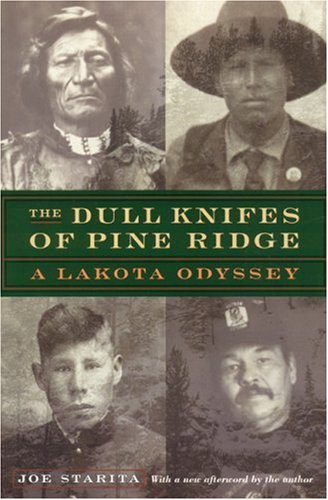From the Bookshelf
Periodic musings on books I like
I have taught the 2nd half of the U.S. survey (1877-present) no less than 8 times and for that course (and other introductory-level surveys) I always pair a textbook with a few solid monographs. Biographies, autobiographies, easy-to-digest analytical monographs, a novel or two, etc… Some books worked well, others did not. One text that consistently received high marks on student evaluations was Joe Starita’s 1995 The Dull Knifes of Pine Ridge.

A journalism professor at the University of Nebraska – Lincoln, Starita conducted hours of interviews with the Dull Knife family and presents a 4-generation narrative: Chief Dull Knife who fought in the 1870s Plains Wars and later led an exodus out of reservation lands in Oklahoma to return to their northern homeland (speaking of which, you MUST check out Jim Leiker and Ramon Powers’ The Northern Cheyenne Exodus in History and Memory – it is excellent!); George Dull Knife, a 1890 Wounded Knee Massacre survivor who later toured with Buffalo Bill’s Wild West Show and enjoyed warm relations with Cody; Guy Dull Knife, Sr., who was a WWI veteran and participated in the Wounded Knee Occupation of 1973; and Guy Dull Knife, Jr., a Vietnam War veteran and artist.
The book was great for a number of reasons. It served to bind familiar late-19th Indian history with less familiar 20th century Indian history. Through the family, students were able to connect themes and concepts from the Plains Wars up to the present. All four generations presented warriors – fighting against and for the United States. But, regardless of who they were fighting, theirs was essentially a Lakota and Cheyenne struggle, and as such, all four featured veterans struggled to cope with their experiences and forge their place in their post-war societies and lives. The experience of Guy Dull Knife, Jr., and his post-Vietnam experiences are particularly striking.
From Plains Wars to WWI to the Wounded Knee Occupation to Vietnam – the narrative is fertile ground for students to chew on comparative ideas. I was able to ask students to consider what Native experiences were shared throughout the 100+ year, multi-generational story. When I asked, “According to Starita’s telling of the Dull Knifes’ story, in what ways have the daily struggles and experiences of Native peoples remained constant over the past 150 years? And conversely, in what ways have they changed?” students consistently surprised me with thoughtful responses. The text is not with out its challenges. Starita does tend to jump around quite a bit, from story to story, and with shared names and overlapping timelines, students often got confused about whose story was being told. I also can’t count how many times I had to explain to students that “Dull Knife” is the family name, so when you speak of them in the plural, you don’t call them “Dull Knives.” MS Word spell check doesn’t like “Dull Knifes.” It is, however, written in an engaging fashion, and quite readable for undergraduates.

I’ve used it several times and it has worked well. I also have an autographed copy from Joe!